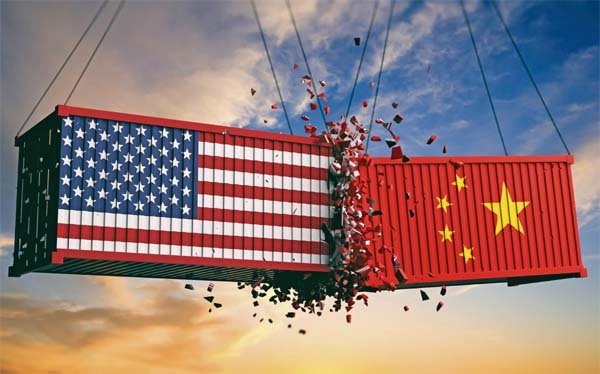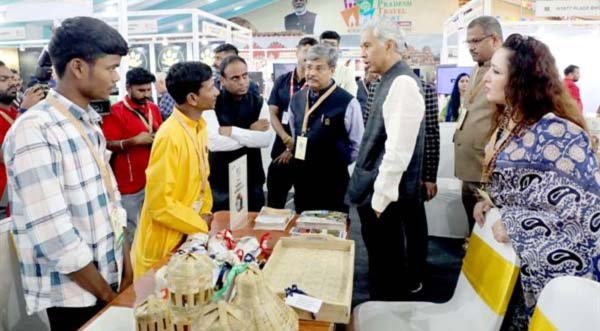SHAHID K ABBAS
New Delhi, Oct 12 (UNI) The recent announcement by the United States to impose a sweeping 100 pc tariff on all Chinese goods from November 1, 2025, marks yet another escalation in the ongoing trade war between the world’s two largest economies.
China’s robust response—declaring, “We do not want a tariff war but we are not afraid of it”—underscores the determination on both sides to defend their economic interests amid rising tensions. This standoff, rooted in complex issues of intellectual property disputes, trade imbalances, and geopolitical rivalry, has far-reaching implications not only for China and the US but also for global trade dynamics and third-party economies, notably India.
The US-China Trade War: A Battle of Tariffs and Retaliations
The US-China trade conflict has been characterized by a series of tit-for-tat tariffs, with the US currently imposing an average tariff of 51.1% on Chinese goods and China responding with an average tariff of 32.6% on American products. The planned doubling of US tariffs to 100% represents a dramatic intensification that threatens to disrupt global supply chains and economic stability. China’s warning of “strong countermeasures” signals a potential spiral that could reverberate across markets worldwide.
India’s Strategic Opportunity Amidst Turmoil
For India, the escalating US-China trade war presents a double-edged sword. On one hand, the higher tariffs on Chinese goods open a window of opportunity for Indian exporters to increase their footprint in the US market. Indian industries—particularly textiles, toys, and electronics—stand to gain significantly as American buyers look to diversify their supply chains away from China’s tariff-induced cost escalations. Already, Indian toy exporters report rising interest from major US retailers like Target, and the Federation of Indian Export Organisations (FIEO) projects substantial market share gains in price-sensitive segments.
India’s exports to the US, valued at $86 billion in 2024-25, position it well to capitalize on this shift. However, success depends on Indian exporters maintaining high standards of quality, compliance, and delivery reliability—critical factors that American buyers prioritize.
The Other Side of the Coin: Challenges in India-US Trade Relations
While India may benefit from the US-China trade friction, it is not immune to its own set of trade challenges with the US. The recent imposition of tariffs by the US on Indian goods—ranging from 25% initially to 50% in key sectors such as textiles, gems, leather, marine products, chemicals, and automobiles—raises concerns about the future of bilateral trade relations. The US attributes these tariffs partly to India’s continued purchase of Russian oil and persistent trade imbalances.
India has strongly condemned these tariffs as “unfair, unjustified, and unreasonable.” The Commerce Ministry’s stance that India will not “bow down” but will seek new markets reflects a growing resolve to assert its economic sovereignty and diversify its trade partnerships.
Balancing Act: Navigating Global Trade Complexities
India’s position today is that of a rising middle power striving to navigate the complex interplay of global trade tensions. The US-China tariff war offers India a unique chance to boost exports and industrial growth, yet the concurrent tariffs imposed by the US on India underscore the fragility and complexity of international trade relations.
Moreover, escalating tariffs globally risk increasing the cost of critical imports such as electric vehicles, wind turbines, and semiconductor parts—sectors vital for India’s own technology and green growth ambitions. This calls for an intensified focus on strengthening domestic manufacturing capabilities, fostering innovation, and enhancing supply chain resilience.
Toward a Rules-Based, Multilateral Trading System
China’s critique of US tariffs as a violation of World Trade Organization (WTO) rules and the call for respect of a rules-based multilateral trading system resonate strongly in today’s fractured trade environment. India, too, stands to benefit from a stable, transparent global trade order that balances national interests with collective cooperation.
In this context, India’s diplomatic efforts to resolve trade disputes and deepen economic ties with diverse partners are crucial. India’s expanding role in global value chains and strategic partnerships can serve as a stabilizing force amid growing protectionism.
India’s Trade Crossroads Amid US-China Conflict
The US-China trade war is reshaping global trade landscapes, with profound implications beyond the immediate protagonists. For India, it is both an opportunity and a challenge—a chance to expand exports and industrial capacity, but also a call to navigate complex bilateral relations and global uncertainties prudently.
India’s future success will hinge on leveraging this moment to build resilient industries, enhance competitiveness, and champion a fair, rules-based trading system that benefits all nations, especially those of the Global South. As the world grapples with rising trade tensions, India’s strategic diplomacy and economic reforms will determine its ability to turn these challenges into lasting growth and global influence.











